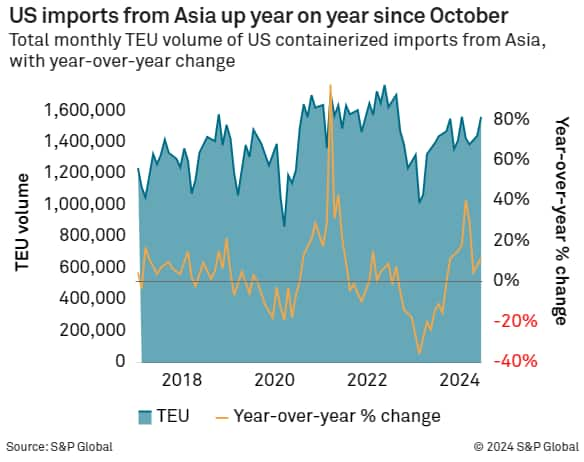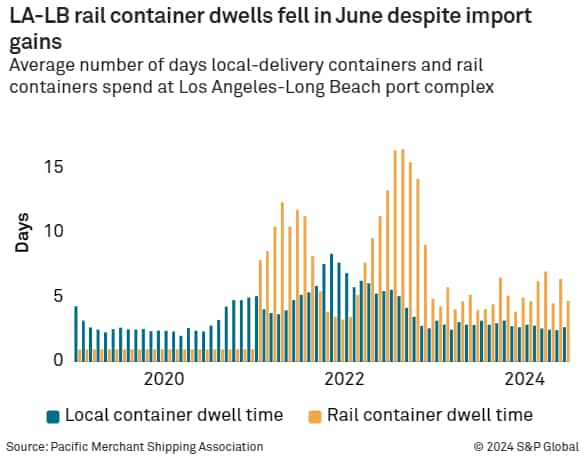Customer Logins
Obtain the data you need to make the most informed decisions by accessing our extensive portfolio of information, analytics, and expertise. Sign in to the product or service center of your choice.
Customer Logins
BLOG
Jul 25, 2024
West Coast ports say ready to handle peak season bump after front-loading surge
Container dwell times improved at North America's major West Coast gateways in June despite strong volume growth amid front-loaded cargoes, and port managers say their marine terminals have both the capacity and fluidity needed to handle what's expected to be a healthy peak season.
Los Angeles, Long Beach, Oakland, Seattle-Tacoma and Vancouver registered double-digit percentage import growth in June, with volumes up 6% at Prince Rupert. Yet rail container dwell times improved from the month before, port managers said, adding that rail networks leading to key inland destinations such as Chicago and Memphis are operating smoothly.
The strong import volumes from Asia are due to several factors, including front-loading of fall and holiday merchandise and a diversion of some discretionary cargo to the West Coast from the East and Gulf coasts due to concerns about a possible strike by the International Longshoremen's Association (ILA).
Having already handled 10 new trans-Pacific services this year while recording improved performance metrics, and with ports along the West Coast of North America operating at 50% to 80% of capacity, the gateways say they are well-positioned to handle additional diversions from the East and Gulf coasts should an ILA strike occur after the current labor deal expires on Sept. 30. Furthermore, a normal seasonal dip in import volumes is likely in November and December, giving West Coast ports an additional buffer.
As the spike in imports has developed, US ports have been sharing with BNSF and Union Pacific railroads advance information on import volumes and operating conditions at marine terminals. The railroads have responded by increasing the deployment of railcars, locomotives and additional staffing to West Coast ports, port managers told the Journal of Commerce this week.
The Northwest Seaport Alliance of Seattle and Tacoma and its terminal operators, for example, hold daily calls with each of the railroads to share data and cargo projections, and railroads adjust their operations accordingly, said Jeff Bellerud, COO of the NWSA.
"We really get tactical," Bellerud told the Journal of Commerce. "We're impressed with the ability of the railroads to handle the spike."
BNSF last month set a company record for direct ship-to-train loadings, beating the prior record that had been set in 2017 by 5%, said Jon Gabriel, the railroad's vice president for innovation, service design and network strategy. BNSF has responded to the West Coast import growth by "surging rail cars, locomotives and crew staffing," he said.
Strong import growth expected to continue
US imports from Asia increased 12.1% in June from one year ago, according to PIERS, a Journal of Commerce sister company within S&P Global.
And retailers are projecting the growth to continue during the August through October peak shipping season. The latest forecast by Global Port Tracker, published monthly by the National Retail Federation and Hackett Associates, forecasts imports will increase 13.5% in August and 3.5% in September year over year.

In response to the import surge, carriers have launched or reinstated 10 trans-Pacific services to the West Coast, seven to Los Angeles-Long Beach and three to Vancouver and Seattle-Tacoma.
LA-LB rail container dwells fell in June despite import gains Average number of days local-delivery containers and rail containers spend at Los Angeles-Long Beach port complex
Noel Hacegaba, deputy executive director and COO at the Port of Long Beach, said the additional services are reflected in an increase in vessels en route to Los Angeles-Long Beach.
"The Marine Exchange reported 70 ships in transit to the San Pedro Bay port complex as of [July 18]," he said. "We typically average 60 ships in transit to the complex."
LA-Long Beach performance indicators improve
According to data from the Pacific Merchant Shipping Association (PMSA), the average dwell time for containers that left Los Angeles-Long Beach marine terminals by rail in June fell to 4.73 days from 6.44 days in May. The average dwell time for containers moved by truck increased slightly to 2.7 days from 2.47 days in May.
Long Beach and Los Angeles are sitting on excess container capacity entering the peak shipping season. Hacegaba said Long Beach is operating at about 67% utilization, and Los Angeles is operating at about 75% to 80% capacity, according to Gene Seroka, the port's executive director.
"The [indicators] are at or better than pre-COVID," Seroka said. "We're in very good shape heading into the second half of 2024."
LA-LB rail container dwells fell in June despite import gains
Average number of days local-delivery containers and rail containers spend at Los Angeles-Long Beach port complex.

The three container terminals in Long Beach operated by SSA Marine remain fluid, with import container dwell times of about three days, said Sal Ferrigno, vice president of SSA Terminals. Unlike earlier this year when the supply of intermodal rail cars provided by the western railroads was lacking, there is sufficient rail capacity today, Ferrigno said.
"Rail car availability is OK now. They fixed it," he said.
Yusen Terminals in Los Angeles has seen a bump in rail container dwells in recent weeks as imports increased, primarily due to the deployment of "extra-loader" vessels in the trans-Pacific, said Yusen President Alan McCorkle.
"There's a little rail backlog eastbound, but it's not excessive," he said. "We're keeping up with it."
Asian imports landing in Oakland in June increased 13.2% year over year, but the port experienced no fluidity issues, according to Carolyn Almquist, the Port of Oakland's maritime manager of business development and international marketing.
"The Port of Oakland has been working closely with its marine terminal partners and we welcome additional cargo," Almquist said. "We've been busy preparing, and we don't expect the cargo to exceed Oakland's capacity. It's not anything we wouldn't be able to handle."
Sea-Tac saw biggest import jump in June
Seattle-Tacoma was the fastest-growing West Coast gateway in June, with imports from Asia increasing 22.8% from June 2023, according to PIERS. The Pacific Northwest gateway has experienced some congestion issues, including rail car shortages and increased rail container dwell times in Tacoma's South Harbor due to the spike in import volumes from the new trans-Pacific services.
"Where things are really hopping is in the PNW ... so it would not surprise me if you started to see some signs of strain developing there," said rail industry consultant Lawrence Gross, president and founder of Gross Transportation.
BNSF is repositioning equipment to Seattle-Tacoma to handle the spike in inland point intermodal (IPI) loadings, but it takes some time for the process to work its way through the network, BNSF's Gabriel said.
Vancouver dwell times lowest of the year
Laden imports to Vancouver in June increased 13.2% year over year, according to the port's website. At the same time, the average rail container dwell time dropped to 4.6 days, the port's lowest of the year, from 6.5 days in May.
The sharing of shipment data in advance of vessel arrivals has been key to maintaining fluidity.
"As a port authority, we work with industry partners, such as rail lines and terminal operators, to ensure there is visibility of the supply chain, including sharing forecast information to support decision making," a port spokesperson said.
Laden imports at the Port of Prince Rupert were up 6% in June from one year ago, according to the port's website. The average dwell time for containers moving to Chicago and the dwell time for Memphis IPI shipments was three days, said Brian Friesen, the port's vice president of trade development.
"We're fluid and sitting on plenty of capacity," Friesen said.
Canadian National (CN) Railway executives, during an earnings call Tuesday, said CN's car velocity was down 3% in the second quarter but trending upward, and that the networks and inland hubs served from Vancouver and Prince Rupert were operating efficiently.
"We had good terminal performance in the second quarter," said Derek Taylor, CN's chief field operating officer and executive vice president. "Our yards were quite fluid throughout the entire network."
Subscribe now or sign up for a free trial to the Journal of Commerce and gain access to breaking industry news, in-depth analysis, and actionable data for container shipping and international supply chain professionals.
Subscribe to our monthly Insights Newsletter
This article was published by S&P Global Market Intelligence and not by S&P Global Ratings, which is a separately managed division of S&P Global.
{"items" : [
{"name":"share","enabled":true,"desc":"<strong>Share</strong>","mobdesc":"Share","options":[ {"name":"facebook","url":"https://www.facebook.com/sharer.php?u=http%3a%2f%2fprod.azure.ihsmarkit.com%2fmarketintelligence%2fen%2fmi%2fresearch-analysis%2fwest-coast-ports-say-ready-to-handle-peak-season-bump-after-fr.html","enabled":true},{"name":"twitter","url":"https://twitter.com/intent/tweet?url=http%3a%2f%2fprod.azure.ihsmarkit.com%2fmarketintelligence%2fen%2fmi%2fresearch-analysis%2fwest-coast-ports-say-ready-to-handle-peak-season-bump-after-fr.html&text=West+Coast+ports+say+ready+to+handle+peak+season+bump+after+front-loading+surge%c2%a0%c2%a0+%7c+S%26P+Global+","enabled":true},{"name":"linkedin","url":"https://www.linkedin.com/sharing/share-offsite/?url=http%3a%2f%2fprod.azure.ihsmarkit.com%2fmarketintelligence%2fen%2fmi%2fresearch-analysis%2fwest-coast-ports-say-ready-to-handle-peak-season-bump-after-fr.html","enabled":true},{"name":"email","url":"?subject=West Coast ports say ready to handle peak season bump after front-loading surge | S&P Global &body=http%3a%2f%2fprod.azure.ihsmarkit.com%2fmarketintelligence%2fen%2fmi%2fresearch-analysis%2fwest-coast-ports-say-ready-to-handle-peak-season-bump-after-fr.html","enabled":true},{"name":"whatsapp","url":"https://api.whatsapp.com/send?text=West+Coast+ports+say+ready+to+handle+peak+season+bump+after+front-loading+surge%c2%a0%c2%a0+%7c+S%26P+Global+ http%3a%2f%2fprod.azure.ihsmarkit.com%2fmarketintelligence%2fen%2fmi%2fresearch-analysis%2fwest-coast-ports-say-ready-to-handle-peak-season-bump-after-fr.html","enabled":true}]}, {"name":"rtt","enabled":true,"mobdesc":"Top"}
]}




